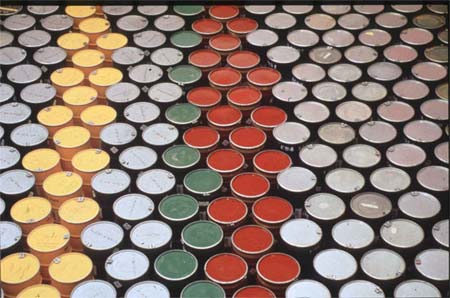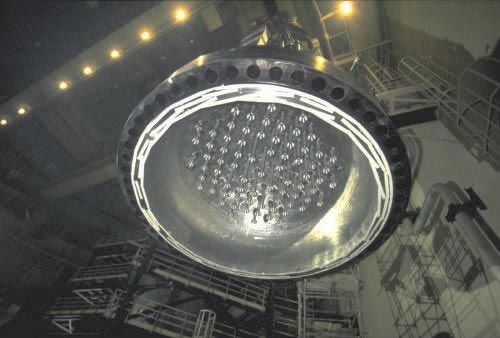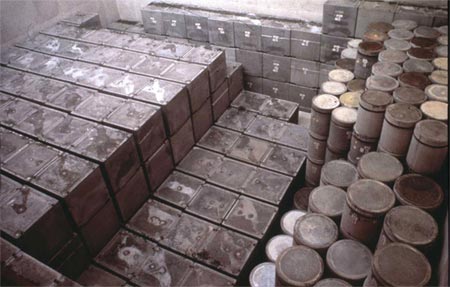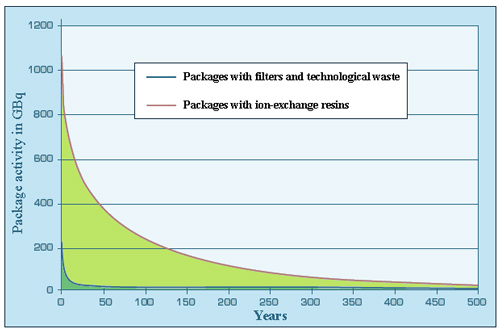Low and intermediate-level waste
Low- and intermediate-level short-lived waste (LILW-SL)
In France, the oldest disposal facility for this type of waste is the Manche center. It reached full capacity in 1993 and is now in a monitoring phase. Waste is now disposed of at the CSA waste disposal facility in the CSA Center (Centre de Stockage de l’Aube) de Soulaines-Dhuys in Champagne-Ardenne, run by ANDRA. It is still being filled.

Metal drums at the CSA waste disposal facility
Metal drums containing low level activity waste in a disposal cell in the CSA waste disposal facility.The radioactivity of this type of waste generally ranges from a few hundred Bq to a million Bq per gram.
© ANDRA

Reactor vessel head
Low-level waste includes exceptionally large objects such as reactor vessel heads that EDF periodically replaces. The vessel head is placed in a large package, which is placed in a shipping cask for transportation to the CSA disposal facility for low- and intermediate-level waste. On arrival, the package is removed from the shipping cask, placed in a disposal cell and embedded in concrete, including inside.
© ANDRA(F3-2-07)
LILW-SL waste, or for simplicity LILW, comes from objects that are contaminated by contact with radioactive products but that are not radioactive in themselves, such as gloves used to handle them.
The radioactivity of LILW-SL waste is considered to be low or intermediate in comparison with the radioactivity of the irradiated fuel from reactors. But it is much higher than that of very low-level waste. Regulations state that the radioactivity of LILW must be below 10 millicuries per kilo (0.37 GBq).
A LILW-SL package consists of 15-20% radioactive waste and 85% encapsulation. At the end of 2010, some 10,000 m³ of this waste was being produced every year.
The majority of the radioactive atoms in LILW-SL waste are beta emitters with a radioactive half-life of less than 30 years, such as cobalt-60. The radioactivity of these short-lived elements will have virtually disappeared in 300 years’ time because it will have decreased by a factor of at least 1000 over this period. Restricting this category to only short-lived radioelements means that it can include waste that is initially intermediate-level.
emitters with a radioactive half-life of less than 30 years, such as cobalt-60. The radioactivity of these short-lived elements will have virtually disappeared in 300 years’ time because it will have decreased by a factor of at least 1000 over this period. Restricting this category to only short-lived radioelements means that it can include waste that is initially intermediate-level.
Despite being referred to as short-lived, LILW-SL does in fact contain some long-lived elements that would be too difficult or costly to remove completely. They are alpha emitters, which are toxic if ingested but are not very mobile. By law, the concentration of alpha emitters must not exceed one hundredth of the limit of 10 millicuries/kg.
emitters must not exceed one hundredth of the limit of 10 millicuries/kg.

Waste containers at the CSA waste storage facility
Disposal of packages of LILW-SL waste at the CSA waste storage facility. Stack of drums and containers made of concrete in a waste cell. The empty spaces between the packages will be filled with cement. Once full, the cell will be covered with a protective layer of earth.
© ANDRA
LILW-SL comes from many different sources. For the most part it is waste from maintenance operations (equipment, tools, cleaning rags, etc.) or from the operation of facilities, such as waste from the treatment of liquid or gaseous effluents at nuclear facilities (filters and resins from the treatment of water from reactors). It can also come from dismantling operations. A small amount comes from research laboratories, hospitals and industry.

Change in the activity of low-level short-lived waste packages
The activity of LILW-SL packages decays relatively quickly because most of the radioactive elements the waste contains have a half-life of less than 30 years. To give an example, the graph shows the decay of two representative waste packages delivered to the LILW waste disposal facility by EDF. The activity is measured in gigabecquerels (GBq, or billions of becquerels) per waste package. The much contribution of a few small amounts of long-lived elements will persist in the long term. The thermal output of these waste packages is negligible.
© Source Andra
There is an industrial solution for the short and medium-term management of LILW-SL. In France it is immobilised in a gangue of concrete, then put in a surface disposal facility. The concrete packages are placed in a clay medium and covered with an impermeable layer and several metres of porous earth.
Other articles on the subject « Waste Classification »
High-level waste (HLW)
Spent nuclear fuels and vitrified waste High-level waste is waste for which management is a prior[...]
Intermediate-level waste (ILW-LL)
Intermediate-level long-lived waste (ILW-LL) The French classification system uses ILW-LL to refe[...]
Very low-level waste (VLLW)
VLLW: very low-level waste VLLW: the least radioactive category Very low-level waste (VLLW) sits [...]
Low-level waste (LLW-LL)
Low-level long-lived waste (LLW-LL) Low-level waste, which has a much lower level of activity tha[...]